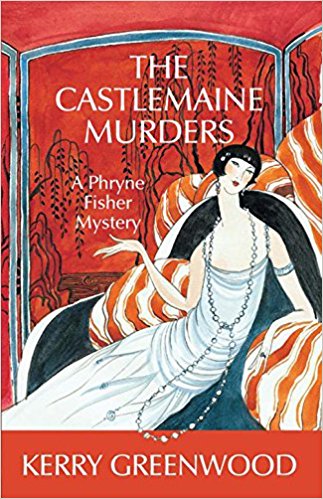 The Castlemaine Murders (Phryne Fisher, #13) by Kerry Greenwood
The Castlemaine Murders (Phryne Fisher, #13) by Kerry Greenwood Formats available: hardcover, paperback, large print, ebook, audiobook
Series: Phryne Fisher #13
Pages: 240
Published by Poisoned Pen Press on July 1st 2006
Purchasing Info: Author's Website, Publisher's Website, Amazon, Barnes & Noble, Bookshop.org
Goodreads
The fabulous Phryne Fisher, her sister Beth and her faithful maid, Dot, decide that Luna Park is the perfect place for an afternoon of fun and excitement with Phryne's two daughters, Ruth and Jane. But in the dusty dark Ghost Train, amidst the squeals of horror and delight, a mummified bullet-studded corpse falls to the ground in front of them. Phryne Fisher's pleasure trip has definitely become business. Digging into this longstanding mystery takes her to the country town of Castlemaine where it's soon obvious that someone is trying to muzzle her investigations. With unknown threatening assailants on her path, Phryne seems headed for more trouble than usual....
My Review:
This was the first time that one of Phryne Fisher’s mysteries gave me a bit of a book hangover. Normally, this series is more like a palate cleanser for me, in that when I find myself in need of a quick, comfortable read, I pick up the next book in the series, read it in one night and the next morning I’m ready for whatever is next on my actual schedule.
The true historical elements wrapped into this story, combined with the cultural background on Chinese immigration and Chinese society in Australia in the 1920s and before were fascinating. Also, unlike most of the books in the series that I have read so far, this particular story was not filmed, nor were any of the elements from this story part of any of the filmed episodes.
So it was both utterly familiar and completely new at the same time.
There are really two stories in this book, running mostly in parallel and eventually meeting up at the end. Phryne uncovers (unmasks, perhaps unboots) a mummy at an amusement park. In spite of the age of the mummy, who while certainly not an Egyptian pharaoh seems to be at least half a century old, someone still seems to be dead – or perhaps deadly – interested in preventing Phryne from discovering who he used to be.
Meanwhile, Phryne’s lover Lin Chung is in the process of assuming control of the Lin family. His venerable Grandmother is still alive, but now that Lin Chung is an adult, control of the family businesses is his. If he can manage to gain that control without offending the old dragon too much, and without making her lose too much face in the process. It’s a delicate balance.
A balance that is made even more delicate when Lin Chung manages to settle a century-old feud between the Lin family and the equally distinguished Hu family. Among the many outstanding issues to be settled between them is the theft of gold from the Lin family and the murder of their four couriers back in 1857, at the height of the Australian gold rush and the depths of anti-Chinese prejudice in Australia.
But when all the accounts are settled between the two families, with nothing left owing on either side, the theft and the deaths are still outstanding, because the Hu family was not responsible. So who was? What happened to the bodies? And what happened to the gold?
Meanwhile, Phryne’s younger sister Beth has been rusticated to Australia by their bully of a father, because she will not marry either of the two men he has picked out for her. And with excellent reasons, even if it does take her half the story to finally reveal all.
It is rather convenient that the mysterious mummy, the missing couriers and Beth’s erstwhile suitor all resolve into one single problem. And it’s also a whole lot of fun to watch it all finally unravel.
Right along with the rope that the villains tie Phryne up with.
Escape Rating A-:This was the right book at the right time. I’ve been reading the Phryne Fisher series in order, but not one right after another. As much as I love the series, what makes reading one seem fresh would get a bit stale if I tried reading a bunch of them back-to-back, no matter how tempted I might be.
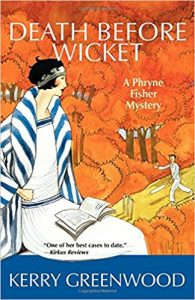 The Castlemaine Murders was one that tempted me a great deal. It had a lot of elements that made it just a bit different from previous books in the series, while, unlike Death Before Wicket, the story was not based on something in which I have neither the interest nor the understanding.
The Castlemaine Murders was one that tempted me a great deal. It had a lot of elements that made it just a bit different from previous books in the series, while, unlike Death Before Wicket, the story was not based on something in which I have neither the interest nor the understanding.
Instead, the mystery in The Castlemaine Murders is all about history. And while the particular mystery that Phryne had to solve was fictional, the events of the Australian Gold Rush in general, including the terrible treatment of the Chinese laborers brought in to work the fields, was all too true. Much of the history that Phryne and Lin Chung investigate really happened, if not quite in the same way as in the story.
A significant chunk of this story revolves around Lin Chung rather than Phryne – they operate separately for much of the narrative. It’s a fascinating introduction to a culture and society that I am not familiar with, while at the same time the prejudices that the Chinese laborers faced in Australia were unfortunately not all that different from what they faced in the California Gold Rush.
This is also to some extent Lin Chung’s coming of age story, as he begins to operate as head of the family and out from under his very formidable grandmother’s thumb. He’s an interesting character in his own right (and in Phryne’s life) and his parts of the story were absorbing.
One of the ways that this story diverges from the TV series, in addition to the significant part that Lin Chung plays in the narrative, is the part of the story relating to Phryne’s sister Beth (who is dead in the series) and their father who is rather feckless in the TV series but a bully and a tyrant here.
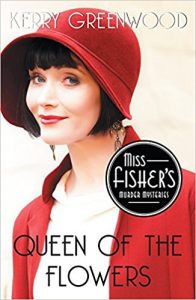 For those reading this book expecting it to be just like the TV show will probably be a bit disappointed, or even censorious about Phryne’s continued relationship with the married Lin Chung. But for those following the book series on its own merits, this one is a treat.
For those reading this book expecting it to be just like the TV show will probably be a bit disappointed, or even censorious about Phryne’s continued relationship with the married Lin Chung. But for those following the book series on its own merits, this one is a treat.
Up next is Queen of the Flowers, the next time I need a comfort reading break!

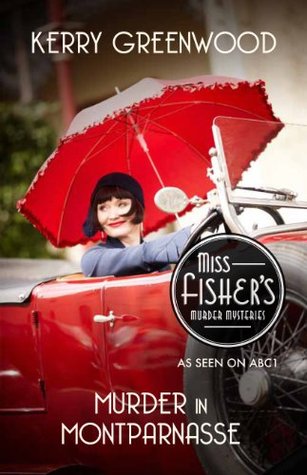 Murder in Montparnasse (Phryne Fisher Mystery #12) by
Murder in Montparnasse (Phryne Fisher Mystery #12) by 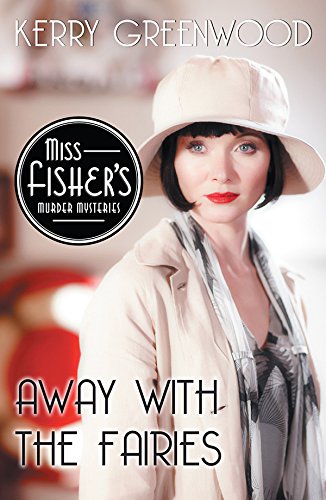 Away With the Fairies (Phryne Fisher Mystery #11) by
Away With the Fairies (Phryne Fisher Mystery #11) by 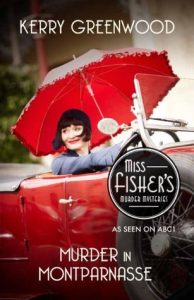 Having recently re-watched the first season of the TV series, the difference between the TV and literary versions of this story stand out even more clearly. The subplot revolving around Phryne’s concern for Lin Chung and her subsequent rescue of him are completely scrapped in the TV version for the weaker and much less compelling murder investigation. And even though I understand why, the story definitely loses something in translation. The story is much stronger in the book. Miss Lavender’s case was too slight and inconsequential to carry the whole story, and it’s better here where it doesn’t.
Having recently re-watched the first season of the TV series, the difference between the TV and literary versions of this story stand out even more clearly. The subplot revolving around Phryne’s concern for Lin Chung and her subsequent rescue of him are completely scrapped in the TV version for the weaker and much less compelling murder investigation. And even though I understand why, the story definitely loses something in translation. The story is much stronger in the book. Miss Lavender’s case was too slight and inconsequential to carry the whole story, and it’s better here where it doesn’t.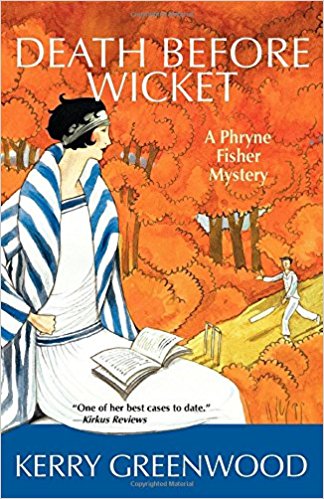 Death Before Wicket (Phryne Fisher Mystery #10) by
Death Before Wicket (Phryne Fisher Mystery #10) by 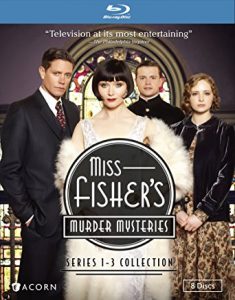 Most of the books in the Phryne Fisher book series were used as inspiration for episodes of the
Most of the books in the Phryne Fisher book series were used as inspiration for episodes of the 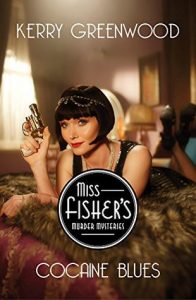 Escape Rating B-: There are lots of reviewers who will say that this is one of Phryne’s adventures that can be given a miss, unless one is either a real fan or a terrible completist. As I’m certainly the latter, and possibly the former, I picked this one up in its proper order. I’m not sorry in the least, but I found the academic setting of the mystery to be perhaps unintentionally hilarious. Academia in the 21st century is not quite as it was in the 1920s, but some of underlying insanity isn’t all that different either. Enough similar that I found enough bits reminiscent to carry me through. If you are looking to start Phryne’s series, do not, on any account, start here. Start with
Escape Rating B-: There are lots of reviewers who will say that this is one of Phryne’s adventures that can be given a miss, unless one is either a real fan or a terrible completist. As I’m certainly the latter, and possibly the former, I picked this one up in its proper order. I’m not sorry in the least, but I found the academic setting of the mystery to be perhaps unintentionally hilarious. Academia in the 21st century is not quite as it was in the 1920s, but some of underlying insanity isn’t all that different either. Enough similar that I found enough bits reminiscent to carry me through. If you are looking to start Phryne’s series, do not, on any account, start here. Start with 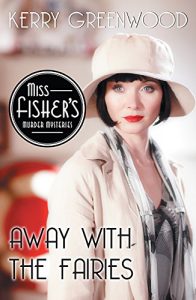 I’m looking forward to going
I’m looking forward to going 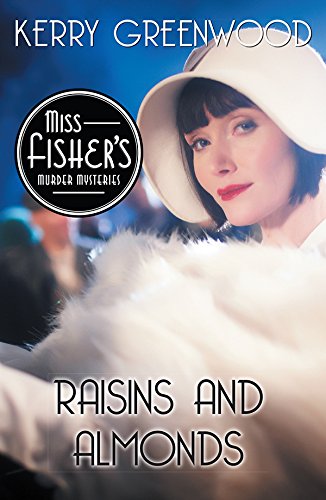 Raisins and Almonds (Phryne Fisher Mystery #9) by
Raisins and Almonds (Phryne Fisher Mystery #9) by 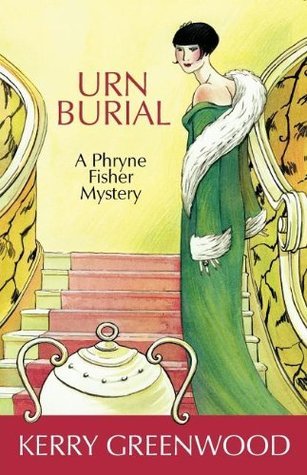 Urn Burial (Phryne Fisher, #8) by
Urn Burial (Phryne Fisher, #8) by 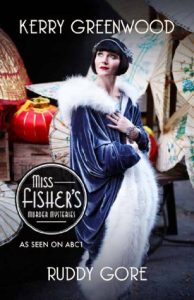 Urn Burial is the 8th book in the
Urn Burial is the 8th book in the 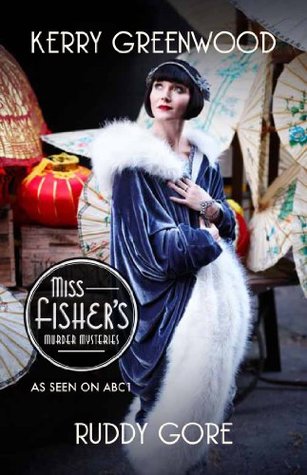 Ruddy Gore (Miss Fisher's Murder Mysteries #7) by
Ruddy Gore (Miss Fisher's Murder Mysteries #7) by 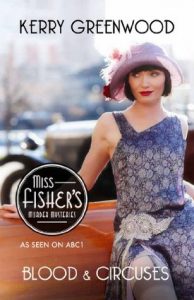 The solution of this particular mystery is all on Phryne. While unlike in her previous outing,
The solution of this particular mystery is all on Phryne. While unlike in her previous outing, 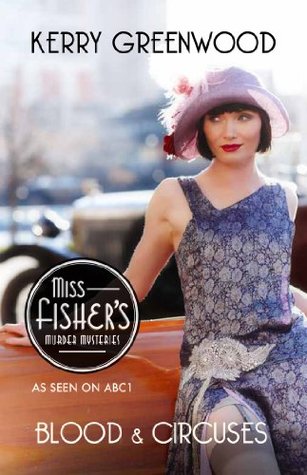 Blood and Circuses (Phryne Fisher, #6) by
Blood and Circuses (Phryne Fisher, #6) by 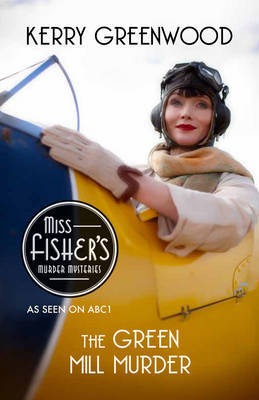 The Green Mill Murder (Miss Fisher's Murder Mysteries #5) by
The Green Mill Murder (Miss Fisher's Murder Mysteries #5) by 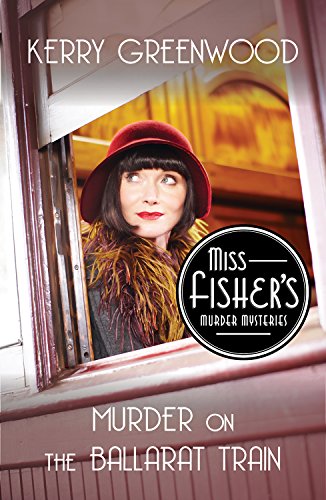 Murder on the Ballarat Train (Miss Fisher's Murder Mystery #3) by
Murder on the Ballarat Train (Miss Fisher's Murder Mystery #3) by 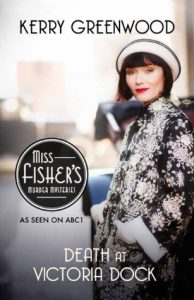 I enjoyed this method of “reading” Phryne’s story just as much as I did reading it. I will, however, make one final note about the audio performance. In any audiobook where a single narrator attempts to voice multiple characters, some characters work better than others. That problem is made more difficult in the case of Phryne, as those of us who have watched the TV show already have a fixed idea of what these characters are supposed to sound like. The narrator of Murder at the Ballarat Train did an excellent job portraying Phryne, and surprisingly a fairly good job of making the male voices sound at least OK. But for some reason my ear kept telling me that Dot’s voice was completely off.
I enjoyed this method of “reading” Phryne’s story just as much as I did reading it. I will, however, make one final note about the audio performance. In any audiobook where a single narrator attempts to voice multiple characters, some characters work better than others. That problem is made more difficult in the case of Phryne, as those of us who have watched the TV show already have a fixed idea of what these characters are supposed to sound like. The narrator of Murder at the Ballarat Train did an excellent job portraying Phryne, and surprisingly a fairly good job of making the male voices sound at least OK. But for some reason my ear kept telling me that Dot’s voice was completely off.